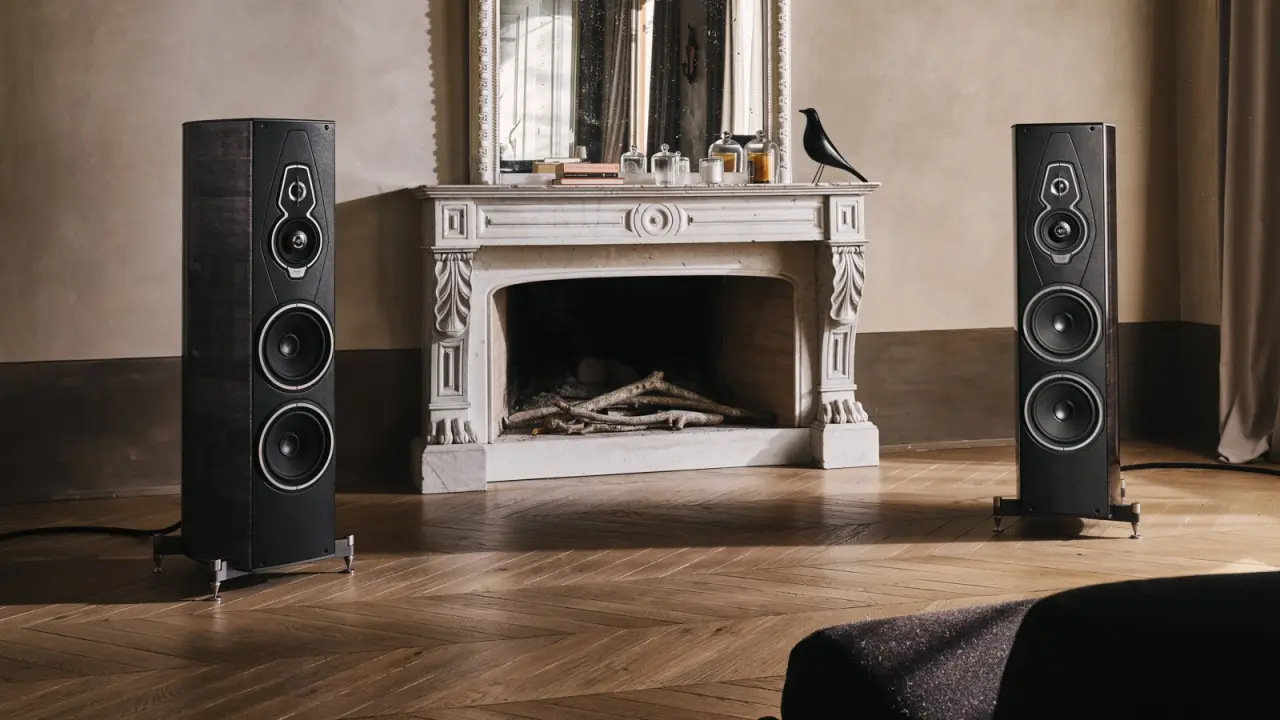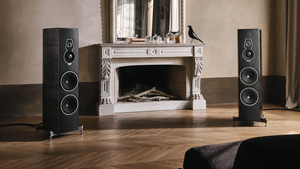
Sonus Faber Amati G5 Review:The Luthier's Art, The Listener's Soul
Introduction: The Sound of Wood and Heritage
To speak of a Sonus faber loudspeaker is to speak of more than electronics and acoustics; it is to speak of Cremona, Italy, the hallowed ground where the art of violin making was perfected. It is in this city, home to masters like Stradivari and Amati, that the Homage collection finds its soul. The Amati G5 is not merely a product; it is the fifth-generation scion of a noble lineage, a direct tribute to the genius of 17th-century luthier Nicolò Amati, who understood that form and function in a musical instrument are inextricably linked.
As the flagship of the renewed Homage collection, the Amati G5 stands as the culmination of an evolutionary process spanning three decades. It represents a profound effort to fuse the irreplaceable character of old-world artisanship with the bleeding edge of acoustic engineering. This fifth iteration, or Generazione 5, promises a significant leap forward in realizing the company's foundational vision.

This raises a compelling question for the modern audiophile: In an era dominated by exotic composite materials and designs born purely from computational analysis, can an instrument crafted from wood, leather, and a deep-seated cultural heritage truly compete at the highest echelon of high-fidelity sound? Does this fifth generation transcend the beauty of its predecessors to become not just a stunning object of desire, but a universally compelling transducer, capable of revealing the heart of any music thrown its way? This review seeks to answer that question.
Part I: Form Follows Emotion - A Study in Craftsmanship
The Lute-Shaped Cabinet
The first encounter with the Amati G5 is a tactile and visual experience as much as an auditory one. The iconic lute-shaped profile, a Sonus faber hallmark, is immediately captivating. This elegant curvature is a masterclass in dual-purpose design. Aesthetically, it evokes the graceful lines of a fine stringed instrument. Acoustically, its non-parallel walls are fundamental to the speaker's sonic purity, effectively controlling the internal standing waves that can muddy the sound in conventional box-shaped enclosures. The result is a form that is not only beautiful but functionally essential to the speaker's performance.
Crowning Carpentry
The term "finish" is an understatement for the Amati G5's enclosure. The cabinet is a complex structure built from nine layers of natural wood, each layer precisely oriented according to its grain, then heat- and pressure-curved into the signature lute shape. This composite wood structure is then painstakingly hand-sanded and finished with nine coats of lacquer, resulting in a depth and luster that rivals that of a concert grand piano.
A pivotal development underscores the G5's refined construction: Sonus faber's 2021 acquisition of the De Santi woodworking facility, its trusted cabinet supplier for 35 years. This strategic vertical integration is far more than a business footnote. By bringing this core competency in-house, Sonus faber has gained unprecedented control over the very element that defines its identity. This allows for a seamless feedback loop between acoustic engineers and master woodworkers, enabling refinements to internal bracing, material selection, and porting systems that were previously impossible. This move ensures that the brand's "secret sauce"—its mastery of wood—is not only preserved but actively advanced, making the G5's cabinet a structurally and acoustically superior evolution directly resulting from this proprietary expertise.

Materials and Refinements
The artistry extends beyond the woodwork. The front baffle is clad in supple leather, which serves not only as a luxurious accent but also as a functional damping material for the driver mounts and the baffle surface itself. For the G5, the metalwork has been refined with smoothed, rounded edges and a new, sophisticated graphite grey anodized finish. At the top and bottom of the cabinet, solid aluminum "dampshelves" are integrated into the structure, further increasing rigidity and reducing resonance without the need for the mass-damping systems of previous generations.
Functional Art
Even the protective grilles eschew convention. In place of cloth-covered frames are elegant elastic "strings" tensioned between two alloy retainers, preserving the speaker's visual lines while protecting the drivers. While aesthetically pleasing, they require a firm, deliberate hand to remove or tension. Underpinning each 55.5 kg (over 122 lb) tower is the Z.V.T. (Zero Vibration Transmission) system. This patented decoupling technology uses specialized spikes and an optimized suspension of alternating metal and elastomer surfaces to mechanically isolate the cabinet from the floor, preventing the transmission of spurious vibrations into the listening environment and preserving the purity of the sound.

Part II: The Anatomy of a Masterpiece - Inside the G5
The Driver Array: A New Voice
While the exterior is a study in classicism, the technology within the Amati G5 is thoroughly modern and represents a significant evolution for the Homage line.
Tweeter
High frequencies are handled by Sonus faber's 28mm D.A.D. (Damped Apex Dome) soft dome tweeter. Its most distinctive feature is the "Arrow Point," a small phase bar that makes gentle contact with the apex of the silk dome. Its purpose is to counteract the natural tendency of a dome's center to move in anti-phase at very high frequencies. By damping this behavior, the D.A.D. system prevents the premature high-frequency roll-off common to many soft dome designs, resulting in a more extended and linear top-end response.
Midrange
The midrange is often considered the heart of a loudspeaker's voice, and here the G5 showcases a comprehensive redesign. The new 150mm driver features a cone made of natural fibers and is driven by a powerful Neodymium magnet system. The motor has been optimized with a shorter, wider voice coil, a change that increases the magnetic force factor for faster transient response and more authoritative control over the cone's movement. Capping the driver is a new, larger "mushroom-shaped" phase plug, developed through extensive computer simulation to optimize the airflow from the cone, reducing turbulence and ensuring a more consistent wave pattern for exceptional clarity both on and off axis.
Woofers



The Acoustic Chamber: Controlling the Energy Within
Intono Technology
One of the most significant innovations in the Amati G5 is the "Intono" technology applied to the midrange driver's enclosure. This is a clever acoustic-mechanical solution to a classic speaker design problem. The midrange driver is housed in its own sealed sub-enclosure, which has a controlled 'leak' or port into a second, separate chamber. This system is tuned to equalize the acoustic pressure on the back of the driver's cone precisely at the frequency where it would normally be highest. By venting this pressure, the Intono system dramatically reduces the large impedance peak typical of a driver in a sealed or ported box, resulting in a cleaner, more uncolored midrange reproduction without resorting to excessive damping materials that can deaden the sound and reduce efficiency.
Stealth Ultraflex Porting
For the woofers, the Amati G5 employs the "Stealth Ultraflex" porting system. Rather than a conventional circular port tube, this system uses a long, vertically oriented slot made of extruded aluminum that exits on the speaker's spine. The carefully profiled shape of this port smoothes the flow of air as it exits the cabinet, reducing the turbulence and associated "chuffing" distortion that can plague lesser designs at high volumes. As a bonus, this substantial aluminum piece also adds significant structural rigidity to the cabinet itself.
The Unseen Conductor: A Hybrid Crossover
The intelligence that unites these advanced components is a completely new hybrid crossover. The design philosophy here is one of elegant simplicity enabled by sophisticated engineering. The linearization of the midrange driver's impedance, achieved mechanically by the Intono system, has a profound electrical benefit: it allows for a simpler crossover circuit with fewer components in the signal path. In high-end audio, a purer, more direct signal path is paramount, as every capacitor, resistor, and inductor has the potential to degrade the signal. Sonus faber has thus invested in a complex cabinet solution to enable a simpler, higher-purity electrical one—a testament to a holistic and deeply intelligent design approach.
This new crossover, featuring "Paracross Topology," is meticulously engineered to be "Phase Coherent". This means that the output of all five drivers is perfectly aligned in time and phase, allowing them to work as a single, seamless source. This coherence is directly responsible for the speaker's uncanny ability to create a stable, three-dimensional soundstage and to "disappear" within the listening room, leaving only the music. The crossover is built with only the finest, hand-selected components, including Jantzen inductors and custom-specification Clarity Caps and Mundorf capacitors, all hand-soldered to custom circuit boards to ensure maximum sonic purity, power handling, and long-term reliability.

Table 1: Technical Specifications
| Feature | Specification |
| System | 3.5-way, Midrange sealed box with Intono, Woofers vented box “Stealth Ultraflex” system |
| Drivers | Tweeter: 28mm DAD Arrow Point Midrange: 150mm Neodymium Magnet System Woofers: 2 x 220mm Dual Drive Motor System |
| Crossover Frequencies | 200Hz, 270Hz, 2,200Hz |
| Frequency Response | 28 Hz – 35,000 Hz |
| Sensitivity | 91 dB SPL (2.83V/1 m) |
| Nominal Impedance | 4 ohm (Minimum 2.36 ohm @ 93Hz) |
| Suggested Amplifier | 50W – 450W |
| Dimensions (HxWxD) | 1176 x 411 x 512 mm (46.3 x 16.2 x 20.1 in) |
| Weight | 55.5 Kg (122.36 lb) each |

Part III: The Performance - In the Presence of Music
Setup and First Impressions
The unboxing and setup of the Amati G5 is an event in itself, a process that immediately communicates the speaker's substantial build quality and presence in the room. As with any high-performance loudspeaker, placement is critical, but the sophisticated porting system seems to make them somewhat tolerant of positioning. Patience is rewarded, as the speakers undergo a noticeable evolution during their break-in period. Initial impressions, which can sometimes seem overly warm or constrained, blossom into a far more open and expressive presentation after several hours of play, a testament to the importance of allowing the drivers' mechanical suspensions to settle.
The Vanishing Act: Soundstage and Imaging
The Amati G5's greatest sonic achievement is its complete and utter disappearance. This is a core strength, a direct result of its phase-coherent design. The soundstage it creates is not merely wide or deep; it is a fully realized, three-dimensional acoustic space. On well-recorded jazz, like Gianluigi Trovesi's Stravaganze Consonanti, instruments are not painted as flat outlines but are rendered as fully formed, palpable entities with uncanny height, width, and depth. Voices and instruments are locked into stable, holographic positions within this space, allowing the listener to perceive the layered depth of a full orchestra or the intimate placement of a small ensemble. The speakers themselves simply cease to exist as sound sources, leaving only the performance hanging in the air before you.

Tonal Purity and Timbral Realism
The overall character of the Amati G5 is one of natural transparency and profound beauty. The sound is rich, full, and liquid, yet it is also remarkably neutral and non-fatiguing, making it ideal for long listening sessions across any genre. The midrange, benefiting from the Intono technology and the new driver, is simply glorious. On Diana Krall's "The Girl in the Other Room," the husky, throaty edge of her delivery is presented with startling realism, perfectly integrated with the body of her tone and never thrust artificially forward. Listening to The Weavers' reunion concert, the speaker reveals the tiniest volume modulations and subtle nuances of phrasing in Pete Seeger's voice, making the performance more emotionally and physically alive than ever before. And, befitting a speaker that pays homage to a violin maker, the reproduction of strings is exquisite: searing and detailed but never hard, strident, or etched, even on the most demanding recordings.

Dynamic Expression: From Whisper to Roar
The Amati G5 is a master of dynamic contrasts. It excels at reproducing the subtle yet explosive microdynamic attacks—the tiny, fleeting gradations of sound at the bottom of the decibel scale—that bring a performance to life. Crucially, it does not need to be played loud to sound alive; it breathes music with ease even at late-night listening levels, a characteristic that separates truly great speakers from the merely good. Yet, when called upon, its capacity for large-scale macro-dynamics is immense. It can handle massive power and play "loud, LOUD, LOUD" with a complete lack of strain, compression, or harshness. On a live recording, the roar of an enthusiastic audience is reproduced with phenomenal energy, getting louder without hardening up or distorting. It can deliver the bone-crunching, jackhammer intensity of The Clash's "London Calling" with the same composure it brings to a string quartet.
The Foundation of Authority: A New Bass Paradigm
For all its refinement, the most surprising and perhaps most impressive aspect of the Amati G5 is its bass performance. Described by one reviewer as "truly jaw-dropping," the low-end is a revelation. The twin 220mm woofers dig deeper than many larger speakers, reaching down to a quoted 28Hz that listening tests suggest is entirely believable. This extension is delivered with an iron-fisted control that is clean, fast, and highly textured. This is not the "one-note bass" that plagues lesser designs; Paul Simonon's bass lines are deep, focused, and utterly convincing in both pitch and texture, never overloading the room or suffering from overhang. This newfound bass authority, a direct result of the powerful new woofer design, marks a significant evolution for the brand. It demonstrates that the Amati G5 is a truly versatile, full-range loudspeaker, equally adept with acoustic jazz, large-scale orchestral works, and hard-hitting rock, resolving any lingering perception that Sonus faber speakers might be too "polite" for certain genres.
This masterful performance demonstrates a successful reconciliation of two often-competing audiophile ideals: "musicality" and "accuracy." The speaker retains the traditional Sonus faber virtues of warmth, beauty, and emotional connection, yet marries them to the modern high-fidelity demands for detail, speed, neutrality, and dynamic range. It achieves this by delivering a torrent of high-resolution information without the analytical, sterile edge that can induce listening fatigue. The Amati G5 proves that one need not choose between the heart and the mind; it speaks directly to both.
Part IV: Conclusions - The Enduring Homage
Synergy and System Matching
To unlock the full measure of the Amati G5's considerable performance, careful system matching is essential. The specification sheet shows a relatively high sensitivity of 91dB, which might suggest it is an easy speaker to drive. However, the lab reports reveal a more demanding side: the impedance drops to a challenging 2.36 ohms at 93Hz. This means the Amati G5 requires an amplifier with not just high wattage, but more importantly, high current delivery and exceptional control. Quality amplification is not an option but a necessity. Amplifiers from manufacturers known for their robust power supplies and smooth, controlled delivery, such as McIntosh or Accuphase, have been noted as successful partners, capable of gripping the woofers and allowing the speaker's natural, transparent character to shine through.
Competitive Landscape
Priced at approximately $36,000 (£30,000), the Amati G5 competes in a rarefied segment of the market populated by exceptional loudspeakers. Its value proposition, however, extends beyond a simple comparison of sonic specifications. It competes not only on its profound musical insight but on its unique and compelling combination of state-of-the-art sound, heirloom-quality craftsmanship, and the intangible pride of ownership that comes with possessing a functional work of art. While other speakers may offer their own flavors of excellence, none offer the same blend of artistic and emotional appeal that is so uniquely Sonus faber.

The Verdict
The Sonus faber Amati G5 is a transducer of immense capability and breathtaking beauty. It presents music as a seamless, coherent whole, never emphasizing one part of the frequency spectrum at the expense of another. It is a speaker that resolves the finest details in a recording while simultaneously revealing its emotional heart, regardless of genre. It is a triumph of holistic design, where every curve of wood, every choice of material, and every technological innovation serves a single purpose: to honor the music.
Returning to the opening theme, the Amati G5 is far more than a loudspeaker. It is a modern masterpiece from the luthiers of Vicenza. It is an instrument that does not just reproduce music but celebrates it. For the discerning audiophile who values artistry as much as accuracy, and for whom music is an essential part of life, the Sonus faber Amati G5 may very well represent the end of a long search—a final, enduring homage to sound itself.






Comments